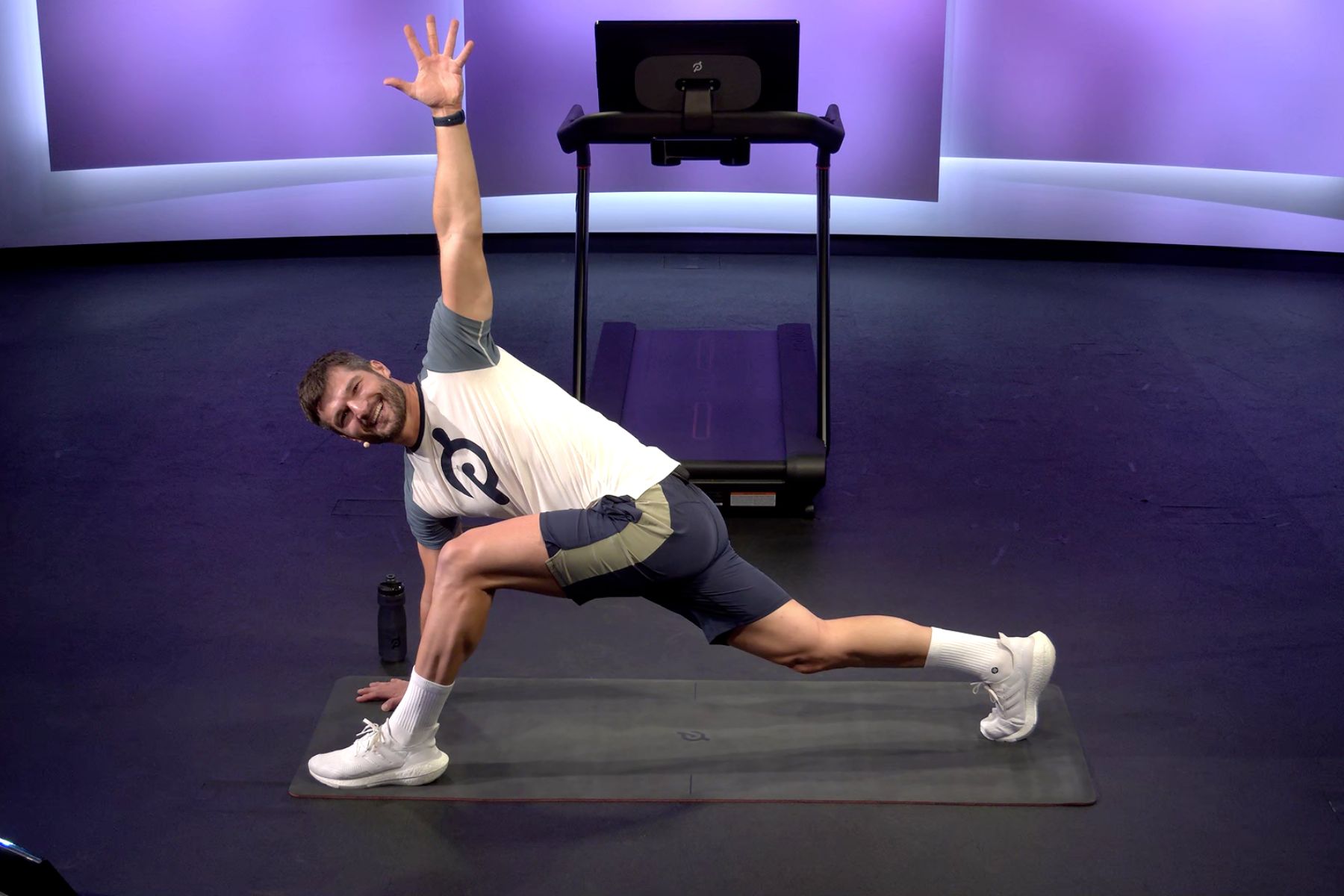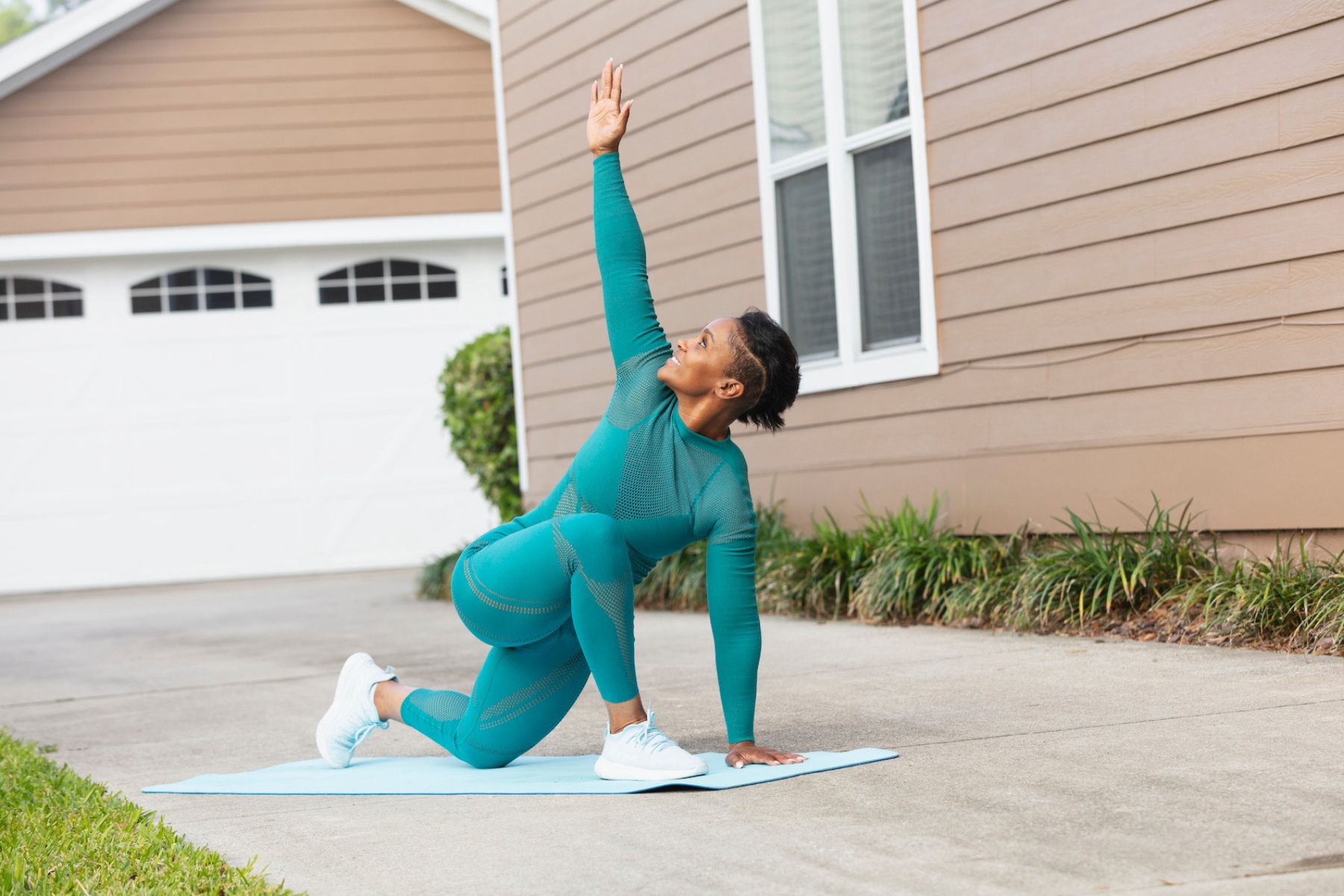
Why We Love The World’s Greatest Stretch (and How To Do It)
Add it to your workout warm-ups and you’ll feel the magic.
By Lauren Mazzo•
What Is the World's Greatest Stretch?
Muscles Stretched By the World’s Greatest Stretch
How To Do The World's Greatest Stretch Correctly
Benefits of Doing the World's Greatest Stretch
World's Greatest Stretch: Modifications and Variations
How and When to Add the World's Greatest Stretch to Your Routine
Most overhyped things don’t live up to expectations, but such is not the case with the move known as the world’s greatest stretch. It’s beloved by trainers; you’ve probably done it in functional workout classes, in the midst of yoga flows, and definitely during Peloton strength warm-ups. But what is it about this stretch that gives it such a confident name—and is it really that great?
Here, we’ll break down the benefits, show you how to do the world’s greatest stretch properly, and offer variations for every level that feel so good.
What Is the World's Greatest Stretch?
At its core, the world’s greatest stretch is a dynamic move done in a deep lunge position with one palm flat on the floor and the other twisting open toward the sky. It’s part lunge, part plank, and part twist, and it involves your entire body. Peloton instructor Jon Hosking, for one, thinks it deserves the name: “The world’s greatest stretch is worthy of that moniker for its versatility and effectiveness in any dynamic stretching routine before a workout,” he says.
Why Is It Called the World's Greatest Stretch?
It’s unclear who invented the world’s greatest stretch, or exactly how it got its name, but it’s called that for a reason: “Part of why they call it the ‘world's greatest stretch’ is because of how many muscle groups you're stretching; and not only stretching, but elongating by moving dynamically in positions that reinforce good alignment,” explains Darlene Marshall, certified personal trainer and author for the National Academy of Sports Medicine (NASM).
Muscles Stretched By the World’s Greatest Stretch
The world’s greatest stretch more or less taps into your whole body—but these are the specific muscles it stretches.
On the straight rear leg, you’re mainly stretching your hip flexors, especially if you're engaging your core and squeezing the glutes on that side to open the hip up, Marshall says. “The calf of that leg will also get some stretch for most people,” she adds.
On the bent leg, you’ll stretch your glutes and the upper section of your hamstrings. Depending on your foot position, it may stretch your calf as well, Marshall says.
Finally, when you spiral open your upper body, you stretch your pecs (chest muscles), shoulders, intercostal muscles (between your ribs), obliques, and other muscles involved with rotation, according to Marshall.
How To Do The World's Greatest Stretch Correctly
It’s worth noting that there are many variations of the world’s greatest stretch. Some trainers combine it with an inchworm to make it a more dynamic warm-up move, some add an initial rotation down toward the floor for more of a back stretch, and some add a kneeling hamstring stretch—but we’ll get into those in detail below. Here’s how to do the simple version of the world’s greatest stretch with proper form.
1. Start in a plank or modified plank.
Start in a wide plank position with your palms flat on the floor directly under your shoulders and your feet about shoulder-width apart. (To modify, drop your knees down to the floor, forming a straight line from shoulders to knees.) Engage your core before moving on to the next step.
2. Step your right foot forward outside of your right hand.
Step your right foot forward so it’s outside of your right hand, with your knee bent at a 90-degree angle, directly over your right foot. Keep your left leg straight in a plank position or, if you’re modifying, with that knee resting on the floor. Keep your core engaged and maintain a long, neutral spine. Try not to round your upper back.
3. Lift your right hand and spiral your chest open.
Inhale to lift your right hand and extend it toward the sky, opening your chest to the right. Don’t allow your left hip to twist, and keep your neck long and core engaged.
4. Lower your right hand and repeat.
Return your right hand to the floor. That’s one rep. Repeat for 30 seconds on the right side for a thorough stretch, or alternate sides to make it more challenging. Do the same number of reps on both sides.
Benefits of Doing the World's Greatest Stretch
The thing about the world’s greatest stretch is that it’s not just a stretch. “It incorporates a variety of transitions and is a truly ‘full body’ movement pattern,” Jon says. It activates ankle-dorsi flexion (the act of pulling your toes toward your shin), calves, hamstrings, glutes, core, and hips while encouraging an opening rotation in the thoracic spine, he explains. And it calls upon your balance, coordination, and stability too.
Because the move is highly adaptable, it’s also what you make it—or what you need it to be. “For a client who has been sick or injured, has a chronic illness, or is elderly, this stretch can be a significant challenge to coordination,” Marshall says. “For clients who are still building a relationship with their body, I use the transition in and out of the stretch as a movement challenge for them, which builds proprioception (the sense of their own body in space) and interoception (the internal sense of one's own body).”
Finally, for someone more advanced, this is a nice dynamic stretch and wake-up, she says. Research shows that a few minutes of dynamic stretching can improve range of motion and decrease stiffness going into a workout.

kali9 / E+ via Getty Images
World's Greatest Stretch: Modifications and Variations
As mentioned above, there are a lot of ways to do this move. Here are the most common variations and modifications for every level.
Rear Knee On the Floor
“With people new to movement, just coming back, or who have very tight hips, I start them with the back knee on the ground,” Marshall says. “That allows for less stress on the hips and back and they can focus on movement quality.”
You can also place your hands on yoga blocks to move the stretch more to your hip and make more room if it’s not comfortable to have your hands on the ground.
Initial Downward Rotation
Many trainers will add in an extra rotation before reaching up to the sky, so you get to drill thoracic rotation in both directions and feel even more of a stretch in your back and shoulders. To do it, you reach the elbow of the moving hand down toward the floor in a thread-the-needle motion, then extend that hand up toward the sky. You can even do the initial rotation with your arm outstretched if you’re really advanced.
Bonus Hamstring Stretch
After twisting open and returning your moving hand to the floor, you can drop your back knee and shift your hips back to extend the front leg and stretch that hamstring.
Dynamic Warm-up Flow
For more advanced exercisers, you can turn the world’s greatest stretch into a dynamic warm-up flow. “I'll have clients start standing, squat down, and walk out to a plank, bring the foot up into the stretch, then rotate the hand up,” Marshall explains. “They'll transition from that position, through a plank, and into the stretch on the other side. From there they return to a wide-footed plank, walk back to a deep squat, and return to standing.”
How and When to Add the World's Greatest Stretch to Your Routine
Jon calls the world’s greatest stretch “perfect before and after any workout.” You can incorporate it anytime you’re stretching, including during a recovery day routine. You'll find this move frequently during warm-ups on the Peloton App, so taking a warm-up class before you jump into another workout is an easy way to get this stretch in.
When done as a flow, it’s especially great as a warm-up for intermediate or advanced exercisers. For beginners, it can be a challenging warm-up just to hold the position, Marshall says. Don’t hesitate to start with your rear knee on the floor, and as you progress or warm up, you can lift it off the ground. “Remember, the goal is building a relationship with your body that feels good and not just a certain number of reps per set,” Marshall adds. And if you need a specific recommendation? Try working on each side for 30 seconds.
If you’re doing the world's greatest stretch as part of a cool-down, you can make the stretch static and hold it for a longer period of time, Jon says. No matter what, remember to keep your chest tall, avoid rounding your spine forward, and—most importantly—don’t forget to breathe.
Related Articles

Stretching + Mobility
The 5 Best Quad Stretches for Runners and Cyclists

Stretching + Mobility
A Beginner’s Guide to Stretching and Flexibility—Plus the 4 Best Stretches to Try

Strength Train
This Lunge Variation Targets the Quads and Glutes. Here's How to Do It

Stretching + Mobility
3 Foam Roller Moves to Soothe Sore Legs
Level up your inbox.
Subscribe for a weekly dose of fitness, plus the latest promos, launches, and events.




